
You’re offline. This is a read only version of the page.



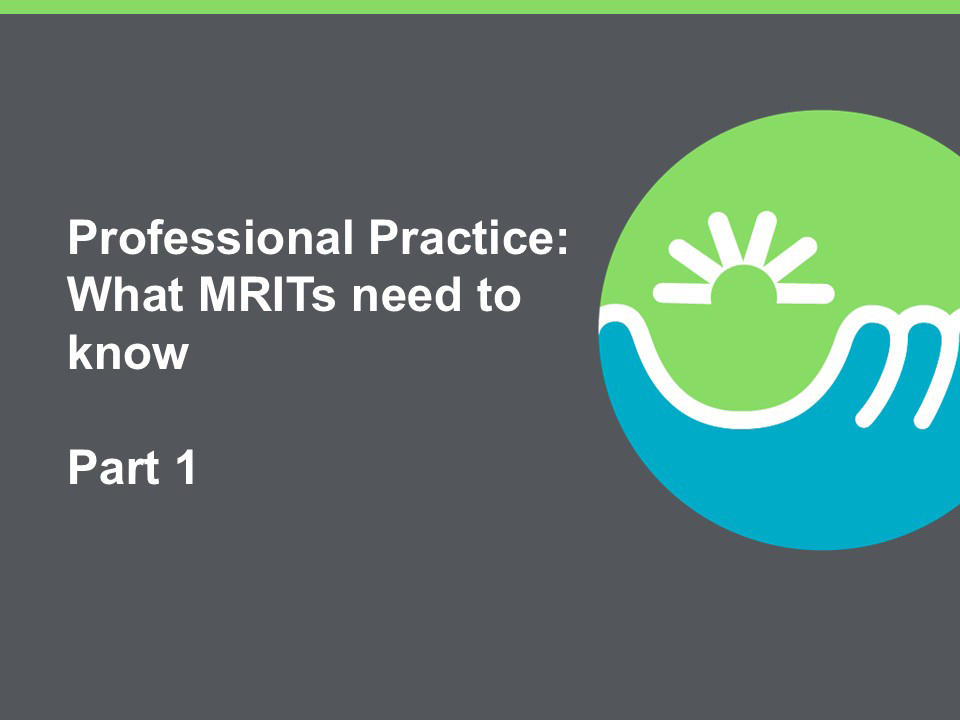
“Professional Practice: What MRITs need to know” is a three-part video series designed to provide students with an introduction to the regulation of medical radiation and imaging technology in Ontario. In Part 1, we discuss professionals and regulation, the role of the CMRITO, and the regulatory context.
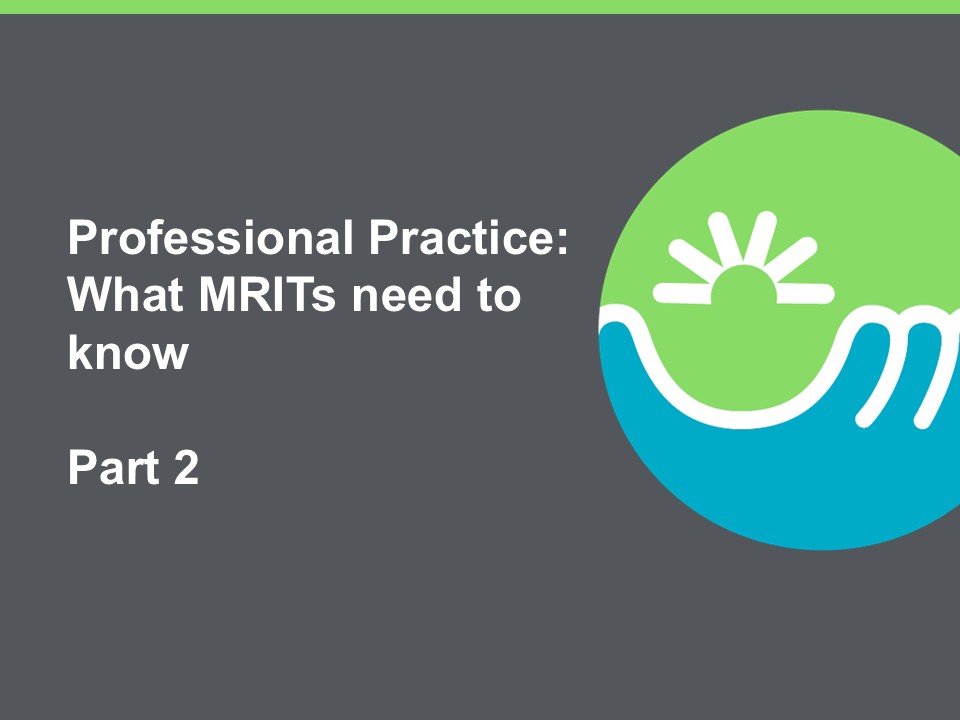
“Professional Practice: What MRITs need to know” is a three-part video series designed to provide students with an introduction to the regulation of medical radiation and imaging technology in Ontario. In Part 2, we discuss the Standards of Practice, principles of communication, and CMRITO's sexual abuse prevention program.
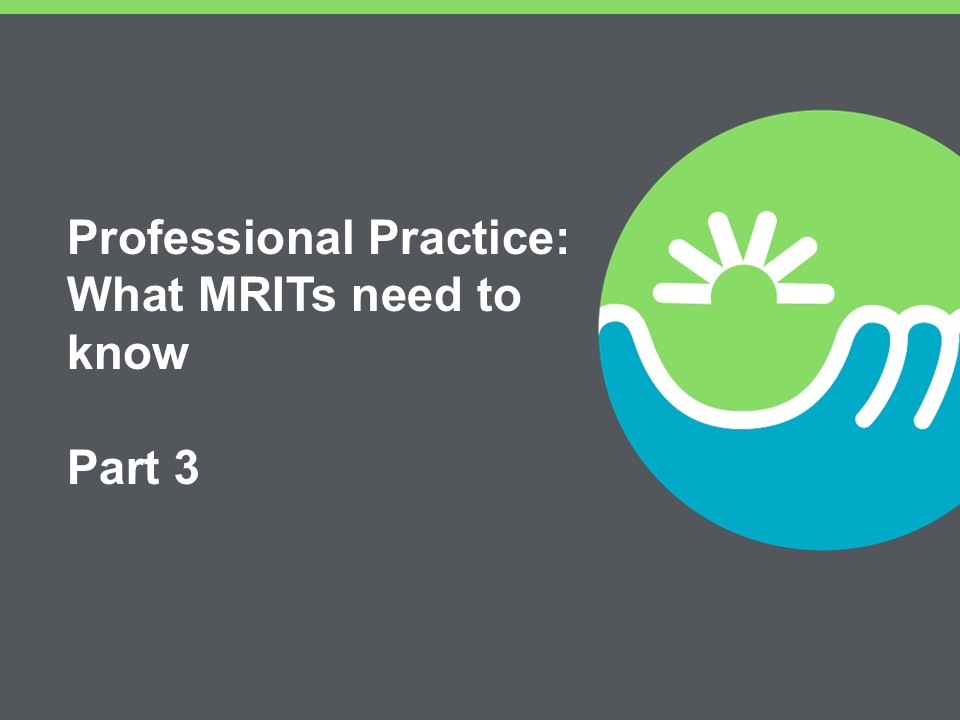
“Professional Practice: What MRITs need to know” is a three-part video series designed to provide students with an introduction to the regulation of medical radiation and imaging technology in Ontario. In Part 3, we discuss registration, the Public Register, the Quality Assurance Program, professional conduct, and accountability.

In this brief video, CMRITO's independent auditor Blair MacKenzie of Hillborn LLP reproduces the content of a presentation given to CMRITO Council at the December 6, 2024 CMRITO Council meeting. The purpose of this presentation is to explain the College's current financial position and demonstrate why it is necessary to increase the annual registration fee at this time.
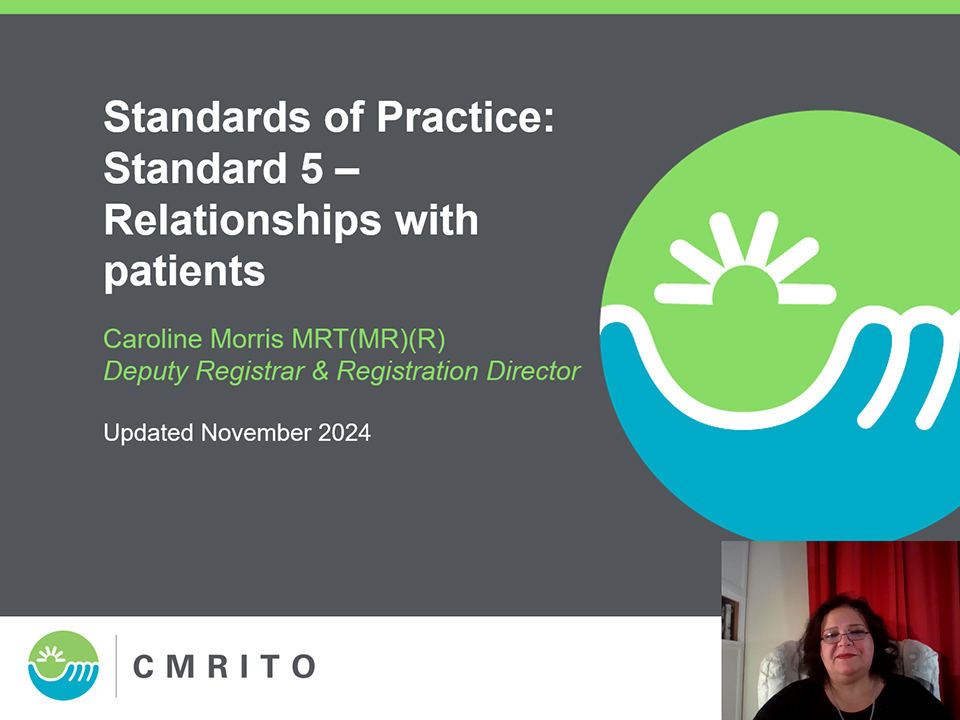
In this edition of the CMRITO's Standards of Practice video series, Deputy Registrar & Registration Director Caroline Morris reviews Standard 5 - Relationships with Patients and how it relates to your practice as a medical radiation and imaging technologist.
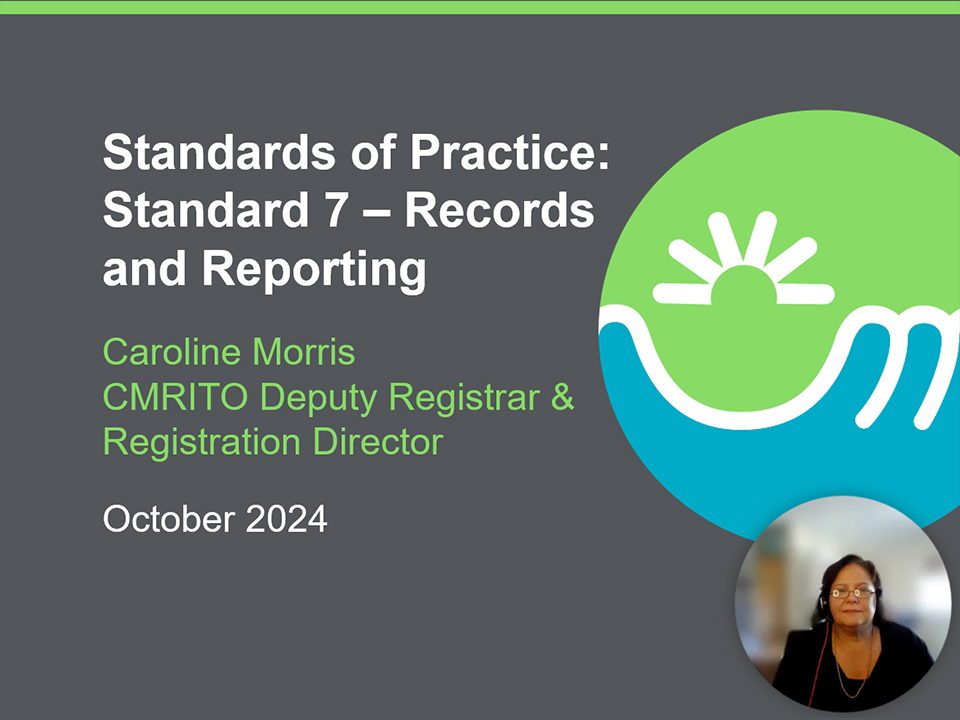
In this edition of the CMRITO's Standards of Practice video series, Deputy Registrar & Registration Director Caroline Morris reviews Standard 7 - Records and Reporting and how it relates to your practice as a medical radiation and imaging technologist.
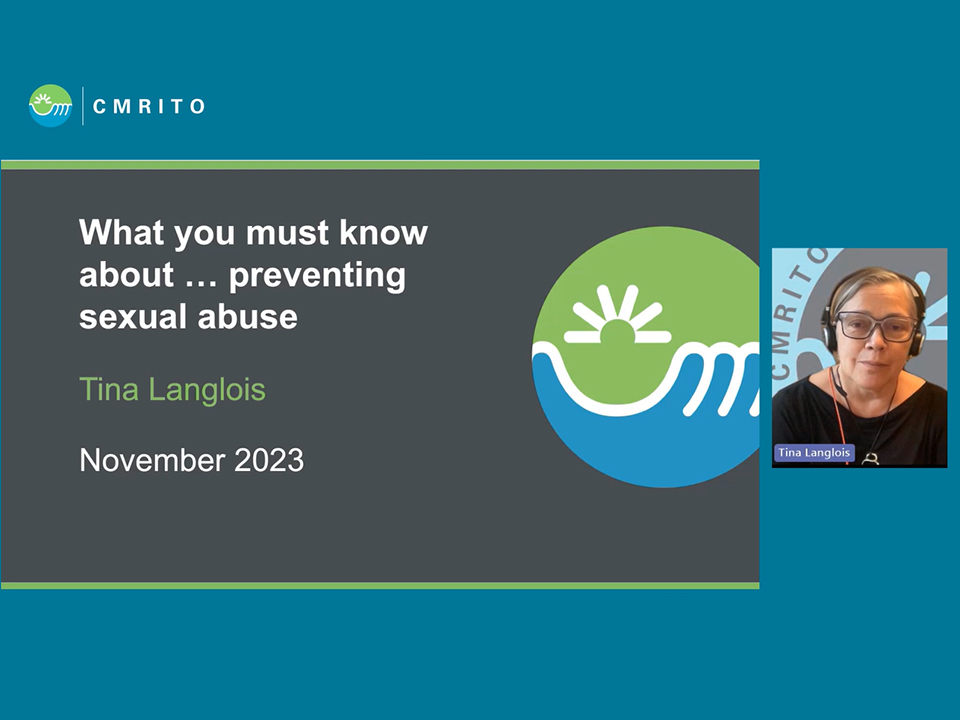
What you must know about … preventing sexual abuse is a comprehensive guide to understanding what constitutes sexual abuse and how best to avoid it. This updated practice guideline explains key principles of communication and touching, and identifies several areas that MRITs must focus on, including: communicating effectively with patients, being active and compassionate listeners, and being aware of and respecting cultural and physical barriers that may interfere with clear communication.

Consent is an essential component of patient centered care, is vital for patient safety, and is required prior to performing any procedure. CMRITO's new practice guideline, What you must know about … consent, outlines the principles of informed consent, identifies what MRITs must explain to patients before starting a procedure, and provides a consent checklist for MRITs to use in practice. Join CMRITO General Counsel Tina Langlois for this webinar as she explains What you must know about … consent.
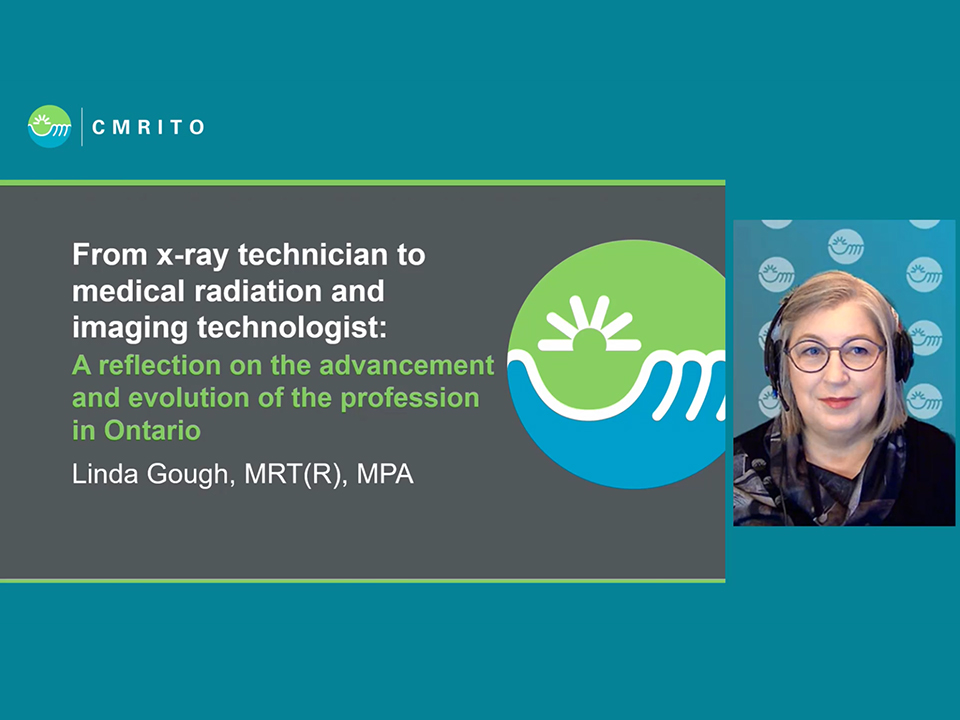
In ‘From x-ray technician to medical radiation and imaging technologist: A reflection on the advancement and evolution of the profession in Ontario’, CMRITO Registrar & CEO Linda Gough reflects on the growth and development of the profession from the beginning of her career to the present day.
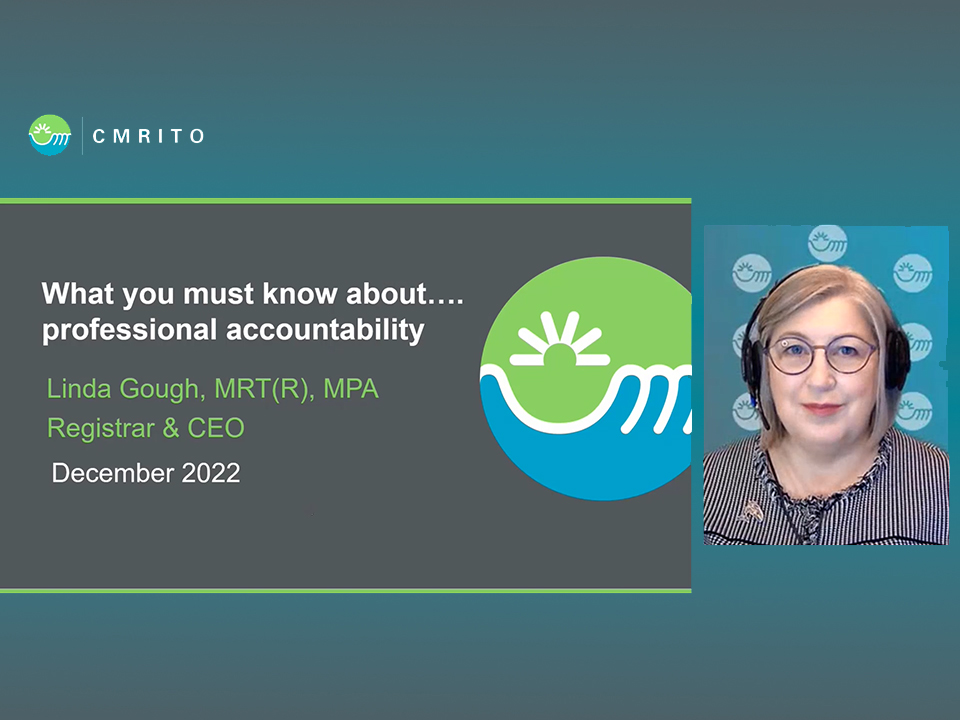
What you must know about … professional accountability outlines how CMRITO members are accountable for their decisions and actions, and for complying with the professional, legal, and ethical requirements that govern the practice of medical radiation and imaging technology in Ontario. Join CMRITO Registrar & CEO Linda Gough for this free lunchtime webinar as she discusses What you must know about … professional accountability.
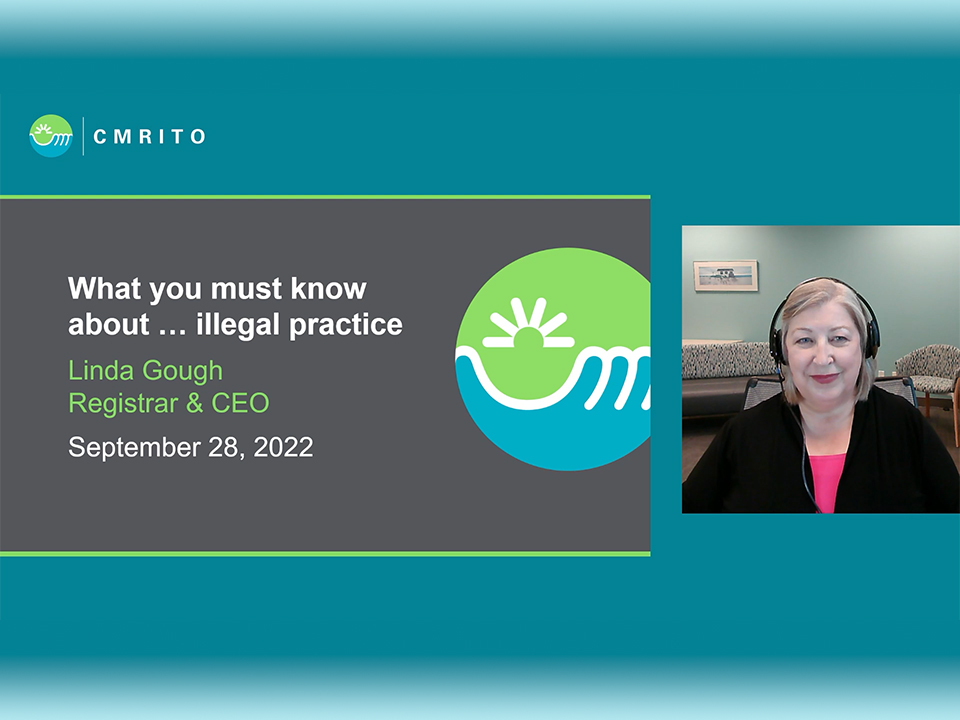
Regulation protects the public by ensuring that only qualified MRITs are registered with CMRITO and able to practice the profession in Ontario. Join CMRITO Registrar & CEO Linda Gough as she discusses What you must know about ... illegal practice, including how to spot illegal practice and what to do about it, how students and applicants can avoid practising illegally before they are registered with CMRITO, and how managers and employers can ensure the MRITs in their facility are registered with CMRITO.
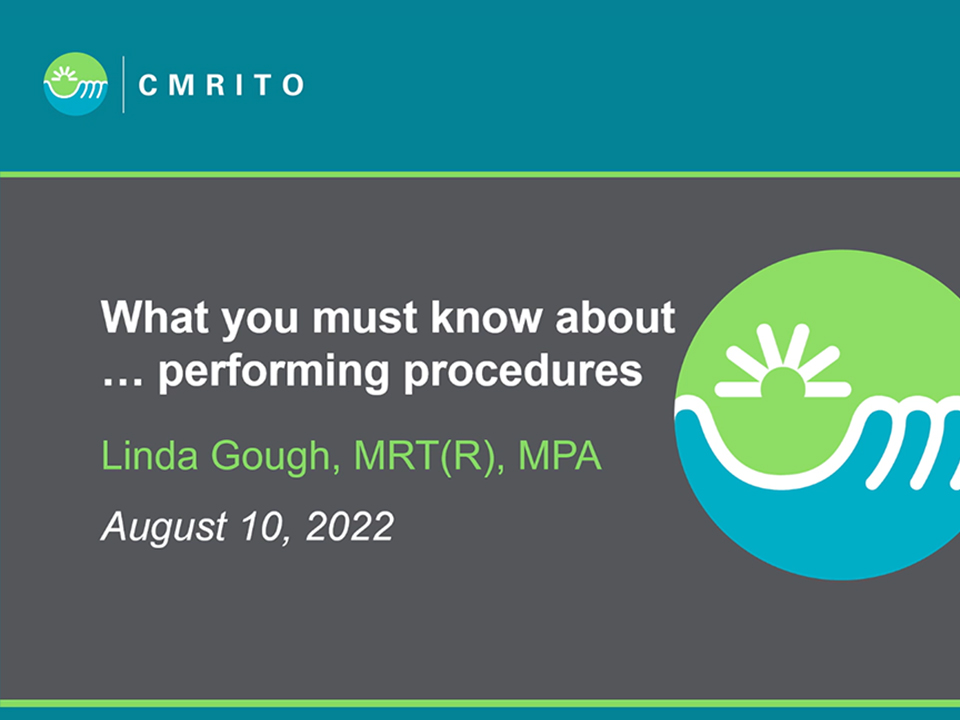
The CMRITO Standards of Practice require members to ensure that several conditions are in place prior to performing a procedure, treatment or intervention. Join CMRITO Registrar & CEO Linda Gough as she outlines the information that CMRITO members must understand to perform medical radiation and imaging technology procedures in accordance with the legislation and CMRITO Standards of Practice in this practical and informative webinar.
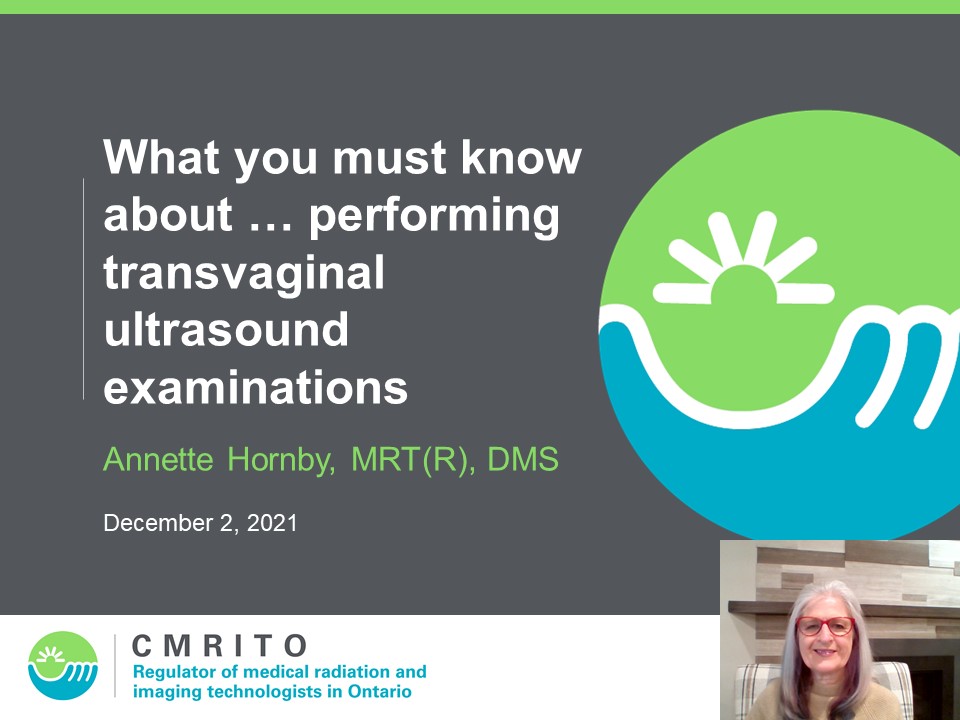
In this CMRITO webinar, Quality Assurance & Professional Practice Director Annette Hornby will review the essentials of clinical practice requirements for diagnostic medical sonographers performing invasive procedures in What you must know about … performing transvaginal ultrasound examinations.
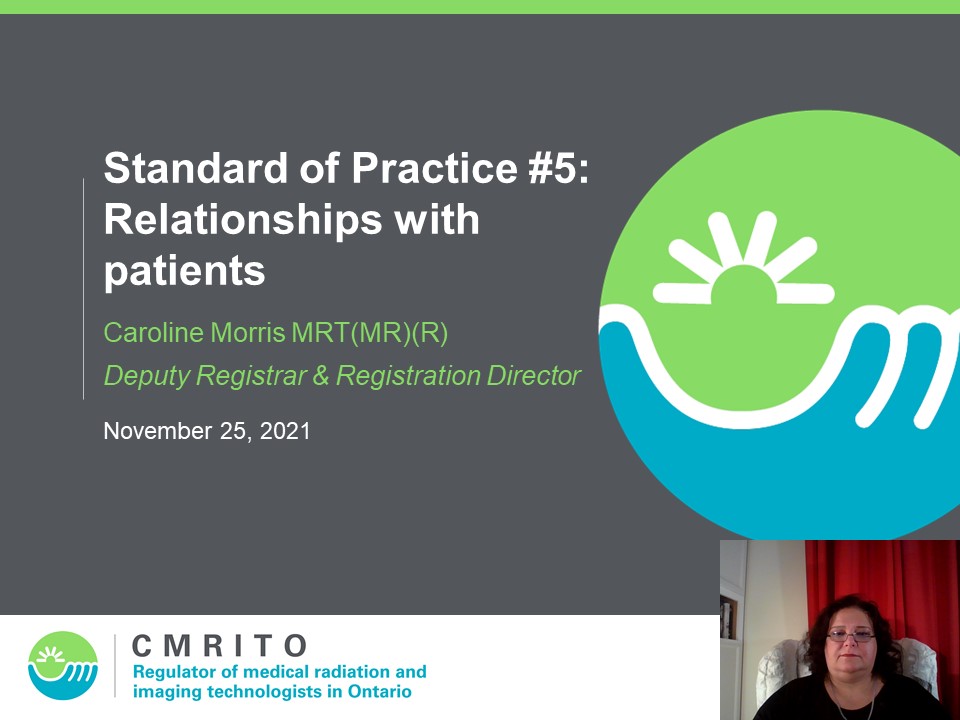
In this half hour webinar, CMRITO Deputy Registrar and Registration Director Caroline Morris reviews the obligations of MRTs and DMSs to always have their patients as their main concern in their clinical practice, as set out in CMRITO Standard of Practice #5: Relationships with patients.
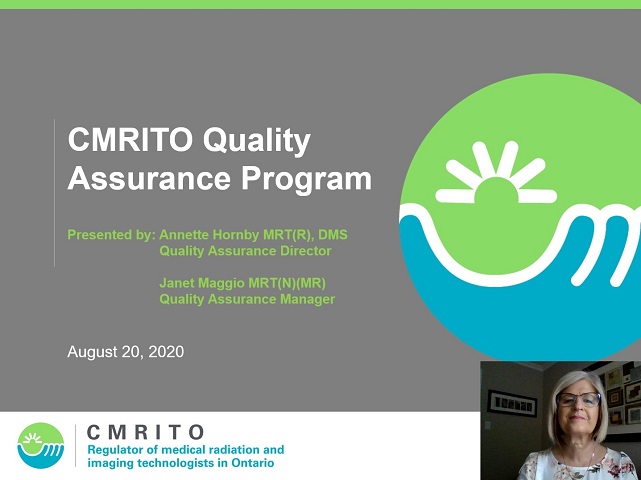
Join CMRITO Quality Assurance Director Annette Hornby and Manager Janet Maggio for this practical and informative webinar as they answer your most pressing questions about CMRITO's QA Program, including:
• “How do I meet my QA obligations?”
• “What learning activities can I use?”
• “Do I have to do 25 hours by my birthday?”
• “What happens if I don’t do my QA?”
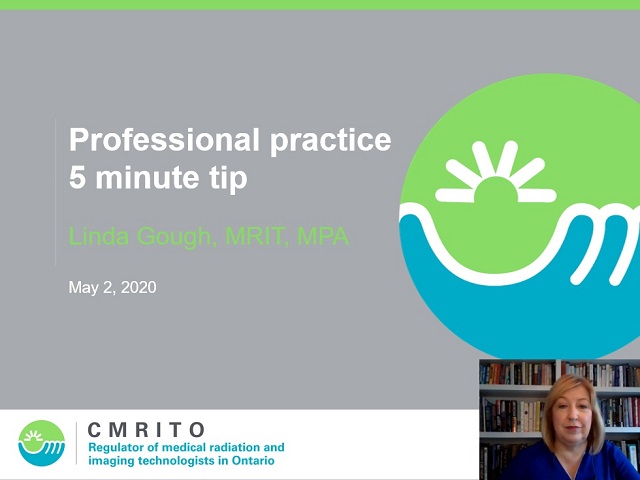
CMRITO Registrar & CEO Linda Gough delivered a short online presentation on protected titles to attendees of the Ontario Association of Medical Radiation Sciences’ (OAMRS) Synergy Through Connection: A Virtual Education Summit in May 2020. MRITs in Ontario can watch this recording of that presentation and learn how to properly use their protected titles.

The Medical Radiation and Imaging Technology Act, 2017 comes into force on January 1, 2020. What does it mean to you, to the profession, and to the College? Join CMRTO Registrar & CEO Linda Gough for this brief but informative webinar outlining what the coming into force of the MRIT Act means and how these changes affect all of us.
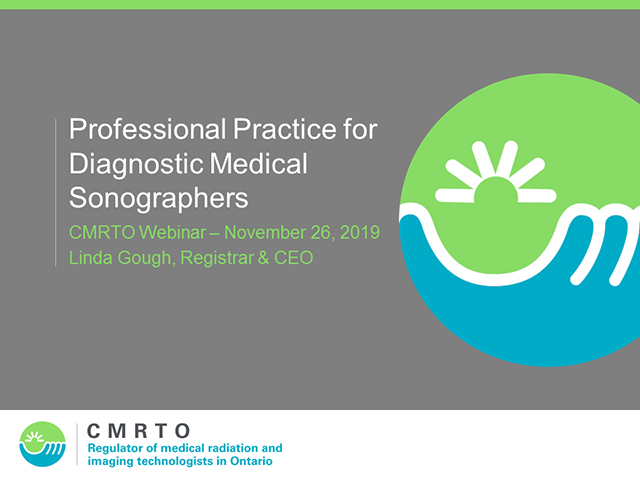
CMRTO has been regulating diagnostic medical sonographers in Ontario since 2018, with mandatory registration commencing at the beginning of 2019. Now, almost one year later, what does this mean to you? Join CMRTO Registrar & CEO Linda Gough as she provides a 45-minute update for sonographers and outlines what your responsibilities are, what actions you are required to perform as newly regulated health professionals, and a quick check on required updates for departmental policies.
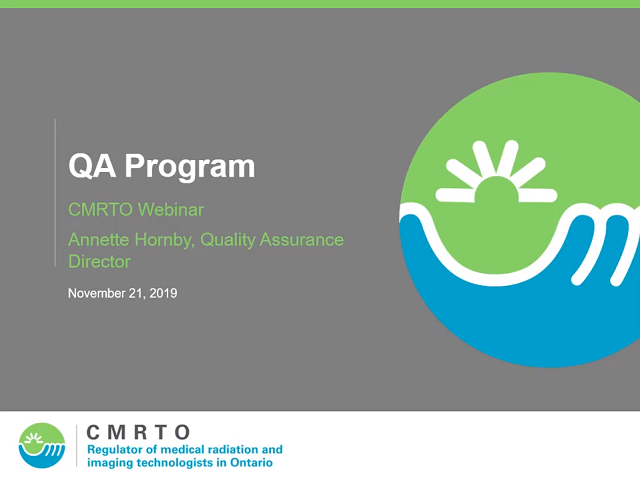
What does CMRTO’s QA program mean to you? What do you have to do when? How can you ensure that your learning and development activities are contributing to your growth and improvement as a medical radiation and imaging technologist? In this webinar recording, Quality Assurance Director Annette Hornby outlines and explains CMRTO’s QA Program.

In anticipation of the Medical Radiation and Imaging Technology Act coming into force, and to inform the public that diagnostic medical sonographers are now regulated by CMRTO, CMRTO has developed a new visual identity and website. This video explains these exciting advances in the protection of the public in Ontario.
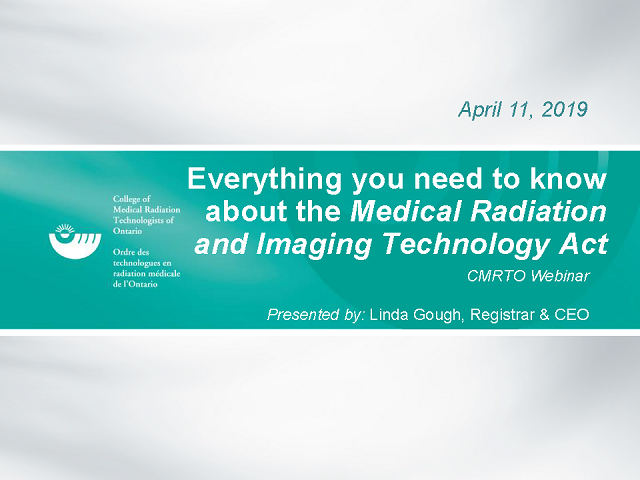
The Medical Radiation and Imaging Technology Act, 2017 (MRIT Act) is expected to be proclaimed into force by the government of Ontario in the near future, repealing and replacing CMRTO’s current governing legislation – the Medical Radiation Technology Act, 1991 (MRT Act).
This 30-minute webinar will answer all of your questions about this important change and its impact on CMRTO members.

The Health Professions Database is an important tool used by Ontario's Ministry of Health and Long-Term Care to shape research, policies and programs for health human resources planning in the province.
This short instructional video shows you how to update this information on the Member & Applicant Portal (MAP).
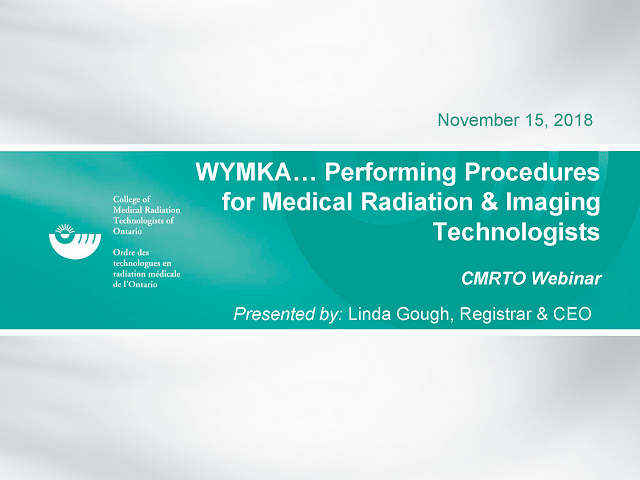
The CMRTO’s Standards of Practice require members to ensure that an appropriate order – an authorizing statement from a regulated health professional with prescribing authority – is in place prior to performing a procedure, treatment or intervention. Join CMRTO Registrar & CEO Linda Gough as she explains the different types of orders, who can issue an order, the practice of delegation and the various steps involved in determining when to implement a procedure as ordered in this practical and informative webinar.

What is mandatory reporting? When are you responsible for reporting professional misconduct, sexual abuse, professional negligence, incompetence or incapacity to the College? In this session, Director of Professional Conduct Tina Langlois discusses mandatory reporting as it pertains to medical radiation and imaging technologists, outlines key roles and responsibilities of members and departments and provides an overview of the complaints process.

What is regulation? What is CMRTO's role in regulating medical radiation and imaging technologists? In this 45-minute webinar, CMRTO Registrar & CEO Linda Gough discusses the structure of CMRTO, including Registration, Quality Assurance, and Complaints. Learn more about us and learn what your professional obligations are.

Effective January 1, 2019, the regulation of diagnostic medical sonography will be fully implemented in Ontario. All sonographers must be registered with CMRTO in order to be legally authorized to practise the profession and to apply soundwaves for diagnostic ultrasound procedures. This webinar will help you understand how the regulation of sonographers by CMRTO affects you and will outline any steps you need to take to ensure that you're ready and able to practice in the new year.
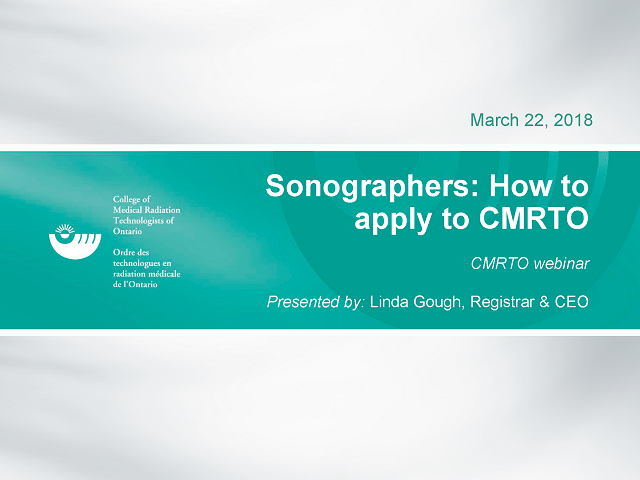
Get the answer directly from CMRTO, the regulator for diagnostic medical sonographers. Join CMRTO Registrar & CEO, Linda Gough, as she explains the application process and tells you everything you need to know about why, how and when you need to apply to the CMRTO.
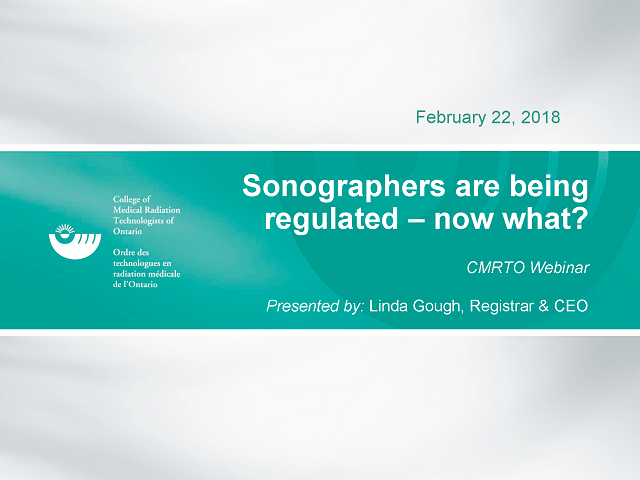
Find out what the regulation of diagnostic medical sonographers, means and next steps. Join CMRTO Registrar & CEO, Linda Gough, as she answers some of the most common questions you have about being a regulated professional, the registration requirements and important timelines.